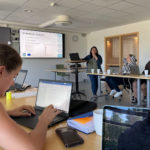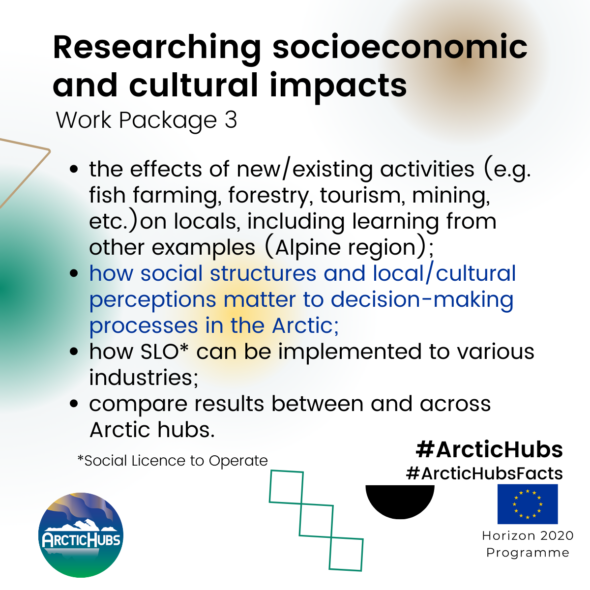As used in ArcticHubs, Q-method is being conducted as part of the in-depth analysis of local people’s perception of the existing and new economic activities in the Arctic. It is being used in particular to assess local stakeholders, policy makers and citizens’ perceptions, in order to identify and cluster like-minded people into so-called opinion types.
This makes viewpoints across different parts of the Arctic region and industries comparable.
Hereafter a description of the method by project colleagues from BOKU University, Jerbelle Elomina and Dr. Ivana Zivojinović, who have been utilising the approach across a number of different projects and in the ArcticHubs project, and they have trained project partners to ensure our broad cohort can confidently apply Q-method in their work.

What is Q-method
Q-method is a mixed qualitative and quantitative method used to study a person’s subjectivity and by subjectivity we mean, a person’s current viewpoint, their opinions, beliefs, values, tastes, perspectives and what do they think and feel about a certain topic (R. Brown 1993).
Typically, there are five steps to conduct Q-method. First is the development of the concourse – which is the universe of statements that can be said about any topic of interest. It consists of ordinary conversation, commentary and discourses of everyday life. The concourse is not limited to words and can include pictures, paintings, pieces of art, music, social media posts and newspaper headlines (Watts and Stenner, 2012). The concourse can also be developed through interviews and existing literature, which is what we did in Arctichubs activities (under WP3.3).
The second step is to select a sample from the concourse which results to the Q-set or a set of Q-statements. A Q-set is typically composed of 20 to 60 statements which are representative of the topic of interest. Next step is the selection of the participants or what we call P-sample – they can be policy makers, specialists, land owners, indigenous people, or ordinary members of the society who have an opinion on the topic. As a rule, the P-sample should be less than the number of the Q-statements. The fourth step and the most crucial is the Q-sorting, or the ranking of the statements along an inverted triangle grid or Q-grid. Participants rank the statements from agree to disagree with varying rank and order based in their own point of view. Q-sorting allows participants to make their point of view objective in that it is available to anyone to see. Finally, as the fifth step, these viewpoints are then analysed using factor analysis to group together people with similar viewpoints.
How and why is it chosen as an appropriate method for Arctichubs project?
The researchers at Arctichubs are using Q-method for a number of following reasons:
- Q-method is a small ‘n’ study, meaning it is less resource consuming;
- More engaging for participants and provides a venue for co-creation during the research process, especially in results interpretation;
- Q-sorting is a more natural process than using questionnaires to provide abstract ratings as participants are provided an opportunity to make their own systematic comparison of all the Q-statements (Gao and Soranzo, 2020);
- Q-method’s outcome is based on holistic thinking process. Participants may easily distinguish the minute discrepancies in their judgements, which also speeds up the decision-making process (Watts and Stenner, 2012).
What is Q-method’s relevance to project aims?
Q-method is used to characterise how different groups of people think regarding a certain topic, in this case, the Arctichubs. Through Q-method
we can explore local people and indigenous people’s perspective about the conflicting land use of the new and existing economic activities in their communities.
With Q-method, we can give form and structure to the different range of perspectives without prioritisation.
This means that ‘marginal’ views are given the same treatment as ‘mainstream’ views. However, this depends on the ability of the researchers to ensure that diverse opinions are represented in the Q-set and suitable participants takes part in the study.
The most important contribution of the results of the Q-method is its input to decision making and in providing suggestions in creating guidelines and policies. For example, if the results suggest that the local stakeholders perceived that economic expansion is the development panacea, then we can say that development projects will most likely be approved and implemented in the region.
Q-method makes viewpoints across different parts of the Arctic region and industries comparable.
With Q-method, we can also test tradeoffs between different economic operation and test how important the issues are (salience) and the emotional value associated with these issues (valence).
The research carried out with Q-method is part of work package 3 activities under the following aims:
References
R. Brown, Steven (1993): A Primer on Q Methodology. In Operant Subjectivity 16 (3/4), pp. 91–138.
Gao, Jie; Soranzo, Alessandro (2020): Applying Q-methodology to Investigate People’s Preferences for Multivariate Stimuli. In Frontiers in Psychology. 11:556509. doi: 10.3389/fpsyg.2020.556509
Simmon, Watts; Stenner, Paul (2012): Doing Q Methodological Research. Theory, Method & Interpretation. London: SAGE Publications.
Stephenson, W. (1935): Correlating Persons Instead of Tests. In J Personality 4 (1), pp. 17–24. DOI: 10.1111/j.1467-6494.1935.tb02022.x.
Watts, Simon; Stenner, Paul (2005): Doing Q methodology: theory, method and interpretation. In Qualitative Research in Psychology 2 (1), pp. 67–91. DOI: 10.1191/1478088705qp022oa.
White, Becky (undated): Methods Vignettes: Q-methodology. Pathways to Sustainability. Online. Accessed 01 Aug 2022. https://steps-centre.org/pathways-methods-vignettes/methods-vignettes-q-method/


